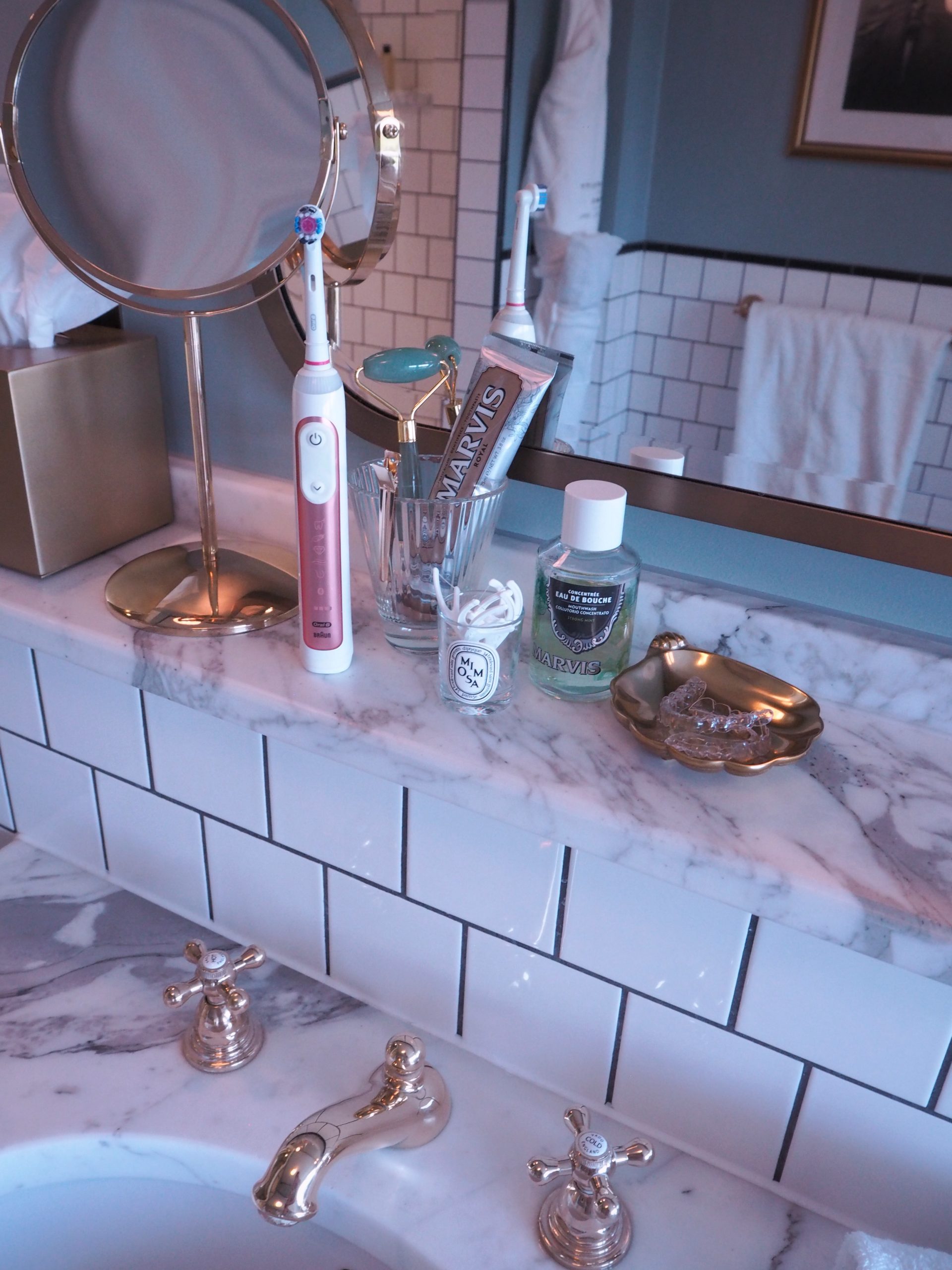
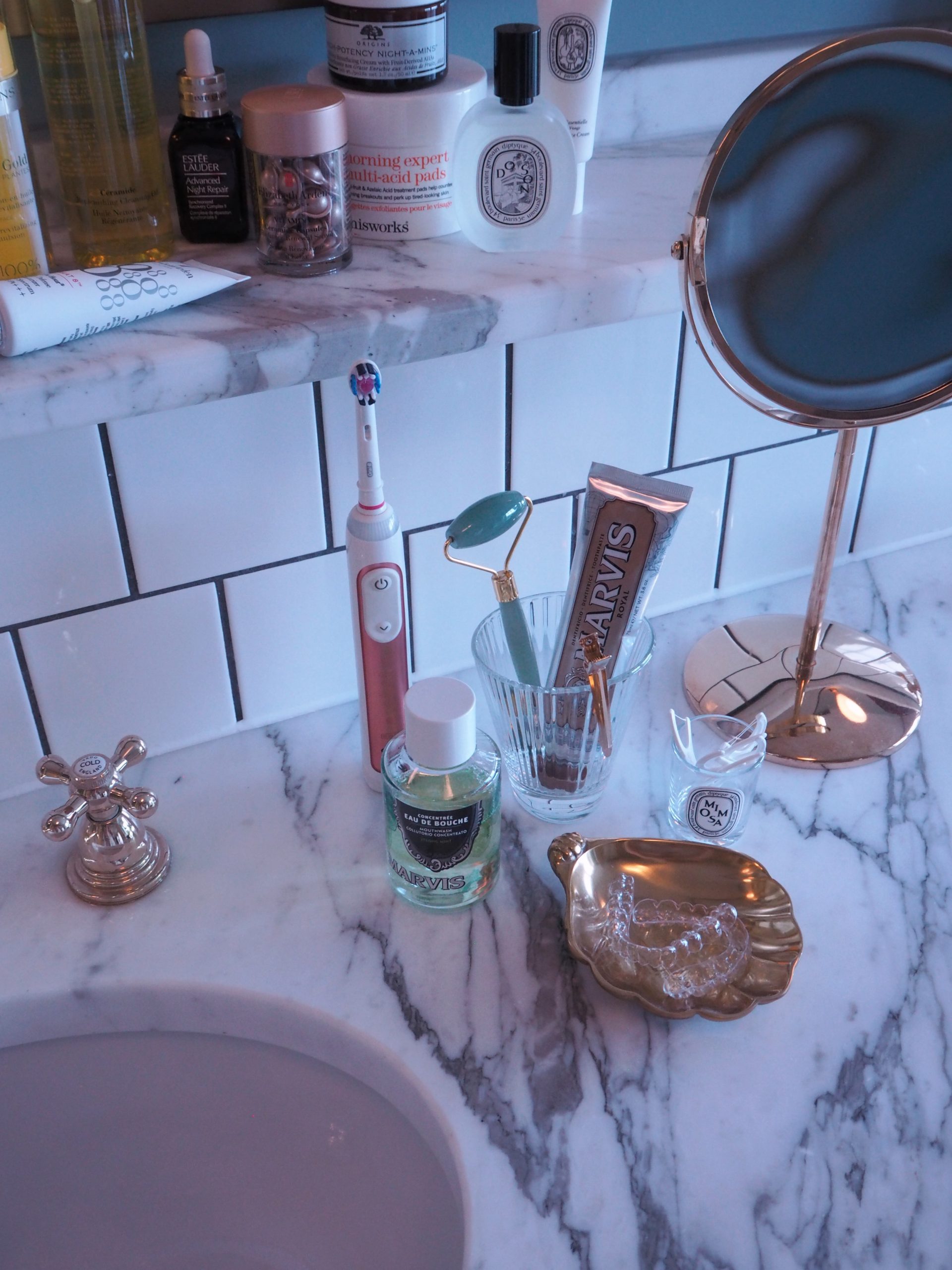 If you’re a regular around here, you might know that I recently completed Invisalign. Although my teeth looked quite straight to begin with, I had a terrible bite that didn’t meet as it should, and my teeth were quite over-crowded and had started to get slightly less-straight each year. I’d contemplated it for years, and after a consultation with the brilliant Dr Francis Scriven at Anglia Orthodontics, finally decided to start treatment in October 2018. I’m so happy I did, and couldn’t be more pleased with the results!
If you’re a regular around here, you might know that I recently completed Invisalign. Although my teeth looked quite straight to begin with, I had a terrible bite that didn’t meet as it should, and my teeth were quite over-crowded and had started to get slightly less-straight each year. I’d contemplated it for years, and after a consultation with the brilliant Dr Francis Scriven at Anglia Orthodontics, finally decided to start treatment in October 2018. I’m so happy I did, and couldn’t be more pleased with the results!
Because this has been one of my most-requested posts since I first mentioned I was having Invisalign, I put call-out on Instagram stories for any questions you had about the process. I hope this is comprehensive and helpful to anyone considering or just starting Invisalign, but please let me know if there’s anything else you want to know and I’ll do my best to answer it in the comments below.
A Few Helpful Tips
- The first few hours of a new set of aligners is the most intense, so always change to your next set at bedtime as that way you’ll sleep through any initial discomfort.
- Make it as routine as possible. If your treatment plan allows, pick a day of the week when you change your aligners and try to stick to that so you never forget.
- If your aligners have any sharp edges along the gum line, you can gently smooth the edges down with a nail buffer to make the aligners feel more comfortable.
- When they’re not in your mouth, always keep your aligners in the same place (at home mine always lived on a little gold shell dish beside my bathroom sink, and when I was away from home they’d always live in a plastic case). I’ve heard too many stories from friends who had treatment who lost them, left them wrapped in a napkin at a restaurant, or even chewed by their dog!
- Always carry gum so that if you’re out and about and not able to properly brush your teeth after eating, you can just chew some gum and rinse your aligners under a tap before putting them back in.
- If you need attachments on your top front teeth, ask if it’s possible to have those attachments put at the back instead so they’re not visible when you talk / smile.
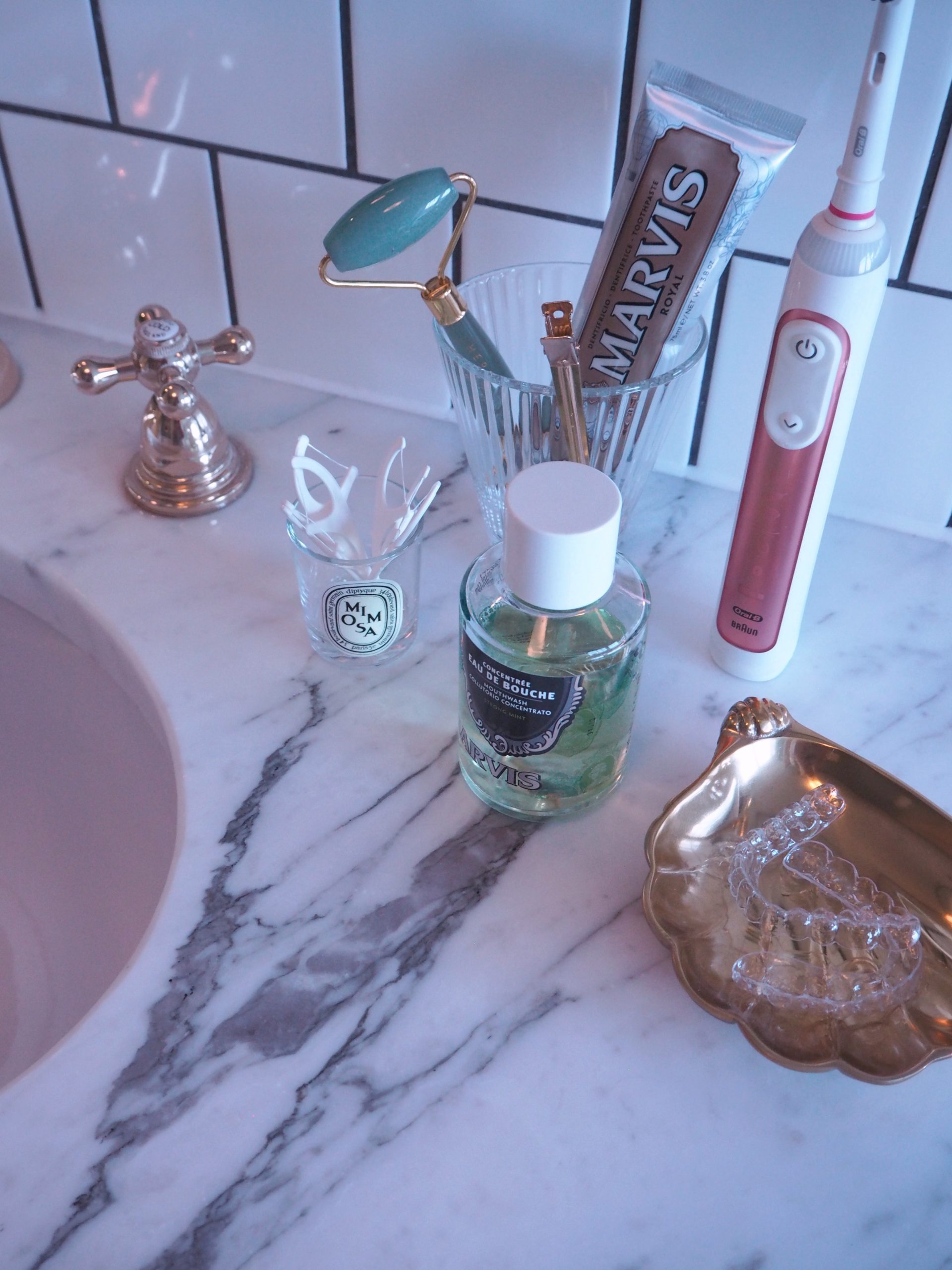
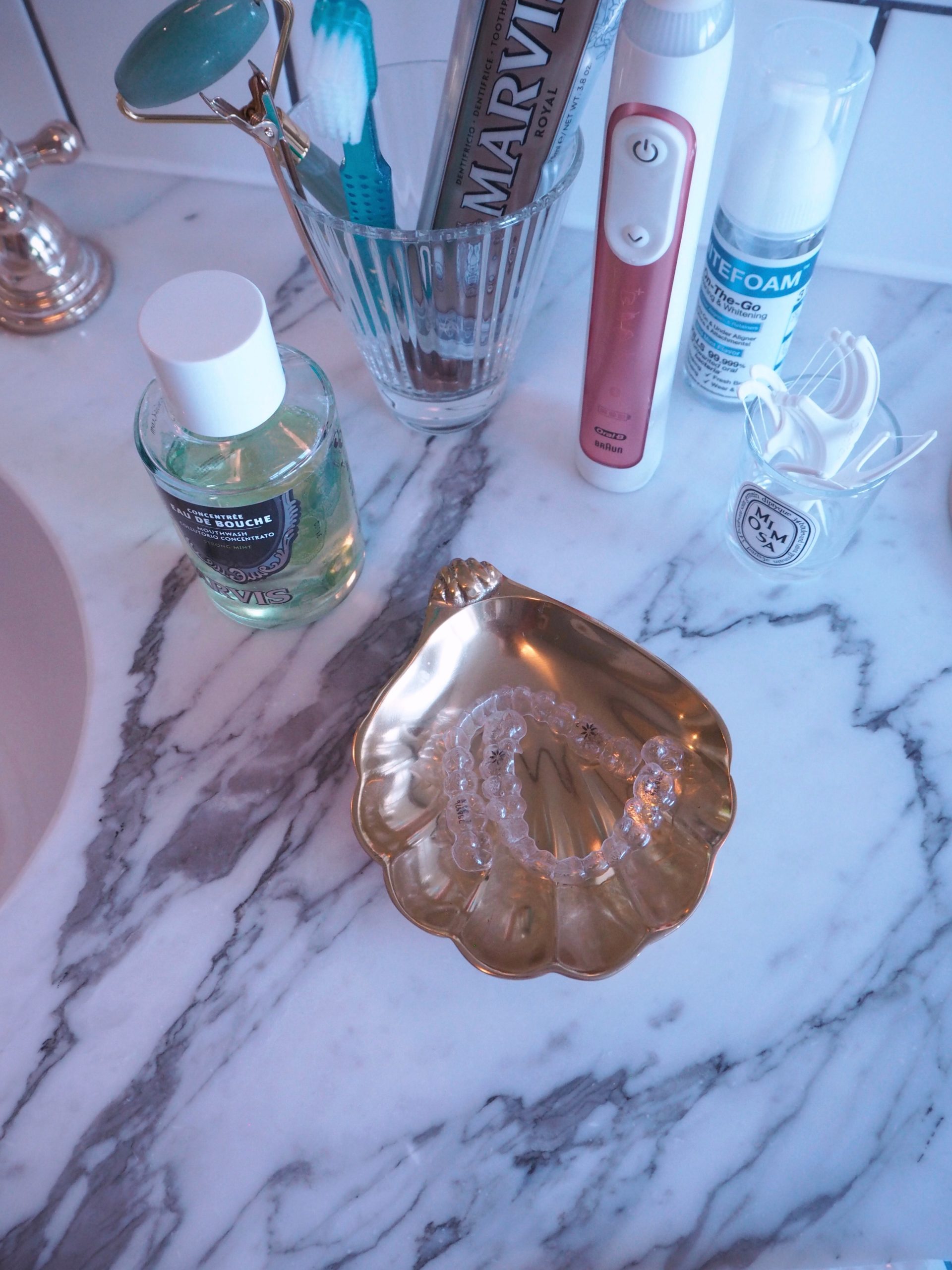 Your Questions Answered
Your Questions Answered
What is Invisalign and how is it different to braces?
Invisalign does the same job as traditional wired braces, but instead of straightening your teeth with wires semi-permanently attached to your teeth, it does so with clear plastic retainers which put a gentle pressure on your teeth. Unlike wired braces, you can remove them to eat, and they’re typically less noticeable and less painful.
Do you need to see an orthodontist to have it, and if so where did you get yours done?
Yes, Invisalign is only offered by fully specialised orthodontists. I had my treatment with the brilliant Dr Francis Scriven at Anglia Orthodontics. If you’re in or near Cambridge, he’s one of the best in the UK and he and his excellent team made the whole process as painless (both literally and figuratively) as possible. I couldn’t recommend them more!
What was the process like?
My treatment took 16 months from start to finish. After my initial consultation, I had a digital scan taken of my teeth which was then used to design my initial treatment plan. A week later I discussed the plan in detail with my orthodontist, he showed me the what the transformation would look like from start to finish, we made a few minor changes (moving some of the recommended attachments to the back so they were invisible, tweaking my bite), and he sent the revised plan back to Invisalign for them to make the aligners. A week later I received my first set which I wore for a week to get used to them, and then had my attachments put on for week 2. I will be honest and say that appointment was traumatic (I must have spent 2 hours in the chair, and then cried out of sheer frustration when I couldn’t get my own aligners in and out at the end of it), but I soon got used to the whole thing. I’d then only go for an appointment every few months (usually when I needed any adjustments or any new refinements), and I’d be sent several weeks or months worth of aligners in between. Once my treatment was finished I had an appointment to have all my attachments removed (yay!) and be fitted for an overnight retainer (which looks just like a clear Invisalign aligner), and then went back a week later to have that fitted along with my permanent retainer. Overall, it was a pretty easy process made even easier by my excellent orthodontist.
Does it hurt?
I wouldn’t say it hurts, but it was a little uncomfortable for the first few days, and occasionally when I’d change aligners. I will say that for the first couple of weeks my mouth would feel dry from constantly having a foreign object in there, and I would have some discomfort from the sharp edges along the gumline (which I learned I could smooth with a nail buffer), but I quickly got used to it. The only time it hurt as such was week 2 when I had my attachments put in which made it harder to get my aligners in and out and the sharp edges gave me a mouth full of ulcers, but again I soon got used to it (and to be honest it was an incentive to get my aligners back in as quickly as possible after eating).
How much does it cost?
This is hard to answer, as the cost varies depending on your individual teeth and how complex your treatment is, but in the UK the ballpark figure is usually between £1500-£4000. Generally, I think the price is roughly the same as traditional wired braces, and most practitioners offer flexible payment options so that you can pay in monthly instalments rather than a lump sum upfront.
How long did it take?
My treatment took a little longer partly because my orthodontist and I are both perfectionists and were happy to additional rounds of refinements to get it just right. My treatment was initially scheduled to take 9 months, but ended up taking 16 months (I started in October 2018 and finished in February 2020).
Are they really invisible?
Almost! I would say the aligner trays themselves are invisible unless you’re looking really closely. I could spot someone else with Invisalign because I was hyper-aware of it, but no one could ever notice until I pointed out that I was wearing them. I would say the most obvious part would be the attachments, which look a bit like tiny bubbles. By way of example, I’m flashing a cheesy grin here and you can just about see the attachments, but not much else.

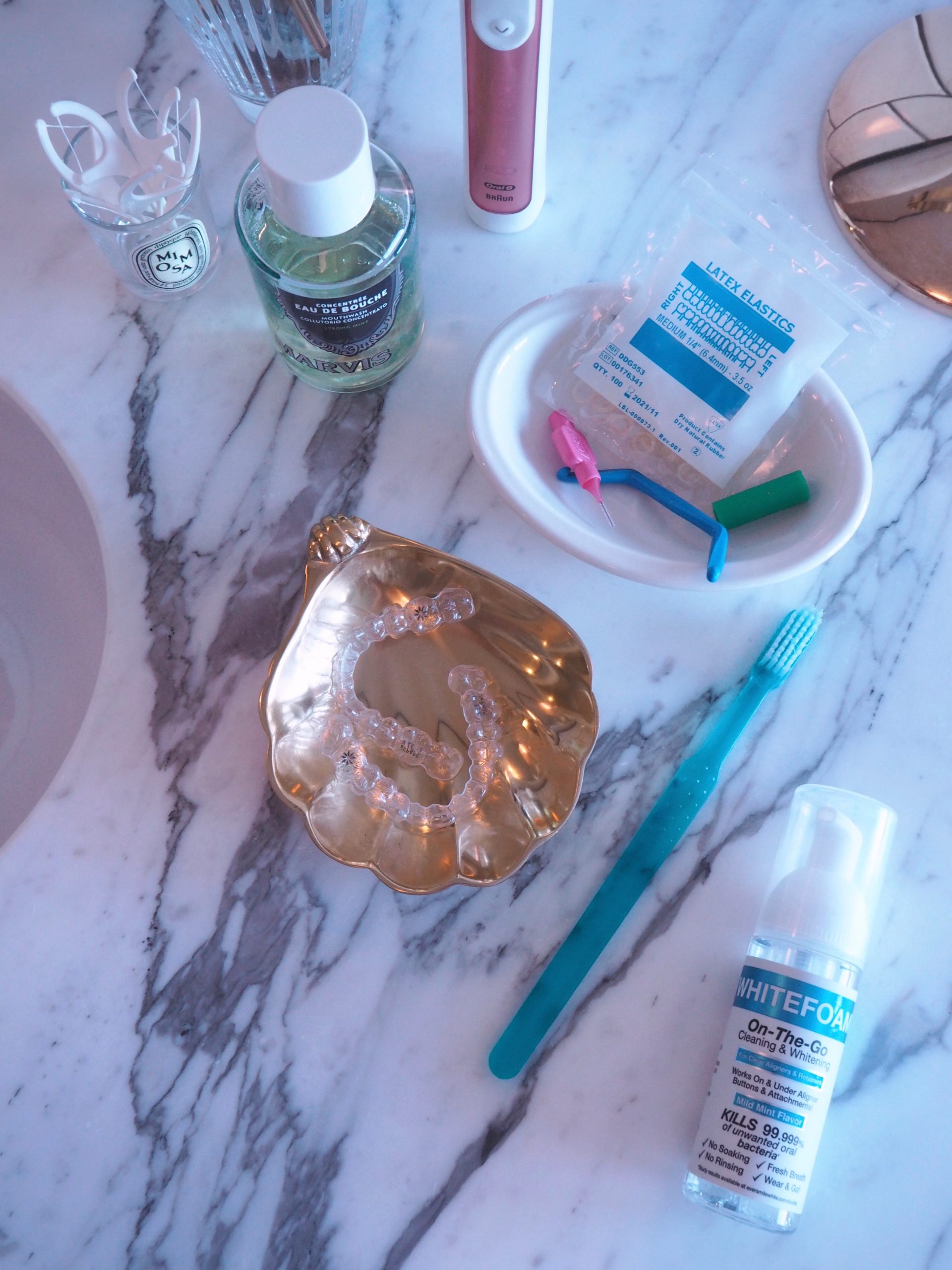
Does it give you a lisp?
At the start, I had such a pronounced lisp that I felt self-conscious whenever I’d speak. But I think mine was made worse because the attachments on my front top teeth were attached at the back, which made them invisible, but also made the aligners take up more room against my tongue (if that makes sense). It did get better each week, but mine never completely disappeared until I finished treatment.
Do you wear them all the time?
Invisalign say you should wear your aligners for 20-22 hours every day, so you only really take the out to eat and clean your teeth. I actually found it more comfortable to have them in than out (because the attachments were sharp and would start to hurt my cheeks after a while), so I’d basically line up all my food so that I could eat + drink as quickly as possible and then get them back in again.
What if you forget to put them in?
There was one morning where I completely forgot to put my aligners back in after brushing my teeth, headed off to work in London, and didn’t realise until my train was pulling out of the station that my aligners were still sitting on my bathroom sink. I was so paranoid that I wasn’t going to be able to get them back in that evening, but it was completely fine (though it did mean by teeth weren’t ready to move onto the next set of aligners that weekend and I had to stay on that same set for a few extra days as a result). Thereafter, whenever I’d have a week with lots of breakfast meetings (meaning they were out for longer than normal at those mealtimes), I’d just try to make up for the hours of wear I missed by eating extra quickly the next day to compensate.
Can you eat and drink with them in?
You’re only meant to drink water when you’re wearing your aligners, because otherwise 1) they’ll stain (a lesson I learned at the start of my treatment when I forgot I had my aligners, tasted a meal I was cooking, and stained my fresh aligners bright yellow thanks to some turmeric…), and 2) food will get stuck to or trapped inside your aligners which means your teeth will basically be bathed in acid (a recipe for tooth decay). I would occasionally cheat and have something light like a peppermint tea if I knew I was changing my aligners that night and therefore didn’t need to worry about them staining, but it’s pretty impossible to eat anything when they’re in.
How often do you need to see your orthodontist?
My orthodontist used a brilliant app called Dental Monitoring, which meant that each week I’d scan my teeth, he’d look at the images, and tell me whether I was ready to move onto the next set of aligners or stay on my current set for a few more days. As a result, I only needed to go in every few months whenever I needed any adjustments, rather than having to go every few weeks as you’d need to do otherwise.
How often do you change your aligners?
I think two weeks used to be the standard time, but with advances in the Invisalign material and technology, one week now seems to be more common. With my treatment, I changed mine every week during my main treatment, and every 5 days during my refinement period, though this may vary between orthodontist and individual treatments.
Do you wear them on the top and bottom?
I personally did, although I believe there is the option to have treatment on just the top or bottom if you wish.
Can you wear lipstick / lip gloss with them in?
Yes, but it’s definitely more effort than usual. I found I could only wear a bright colour if it was really matte and budge-proof and I only re-applied after I’d just put them back in (not just before removing them). At one point I tried to wear a red shade in a creamy formula, and looked like a vampire approximately 2 minutes later because it had transferred all over my aligners. Otherwise I’d stick to light shades or tinted balm and found those to be safe.
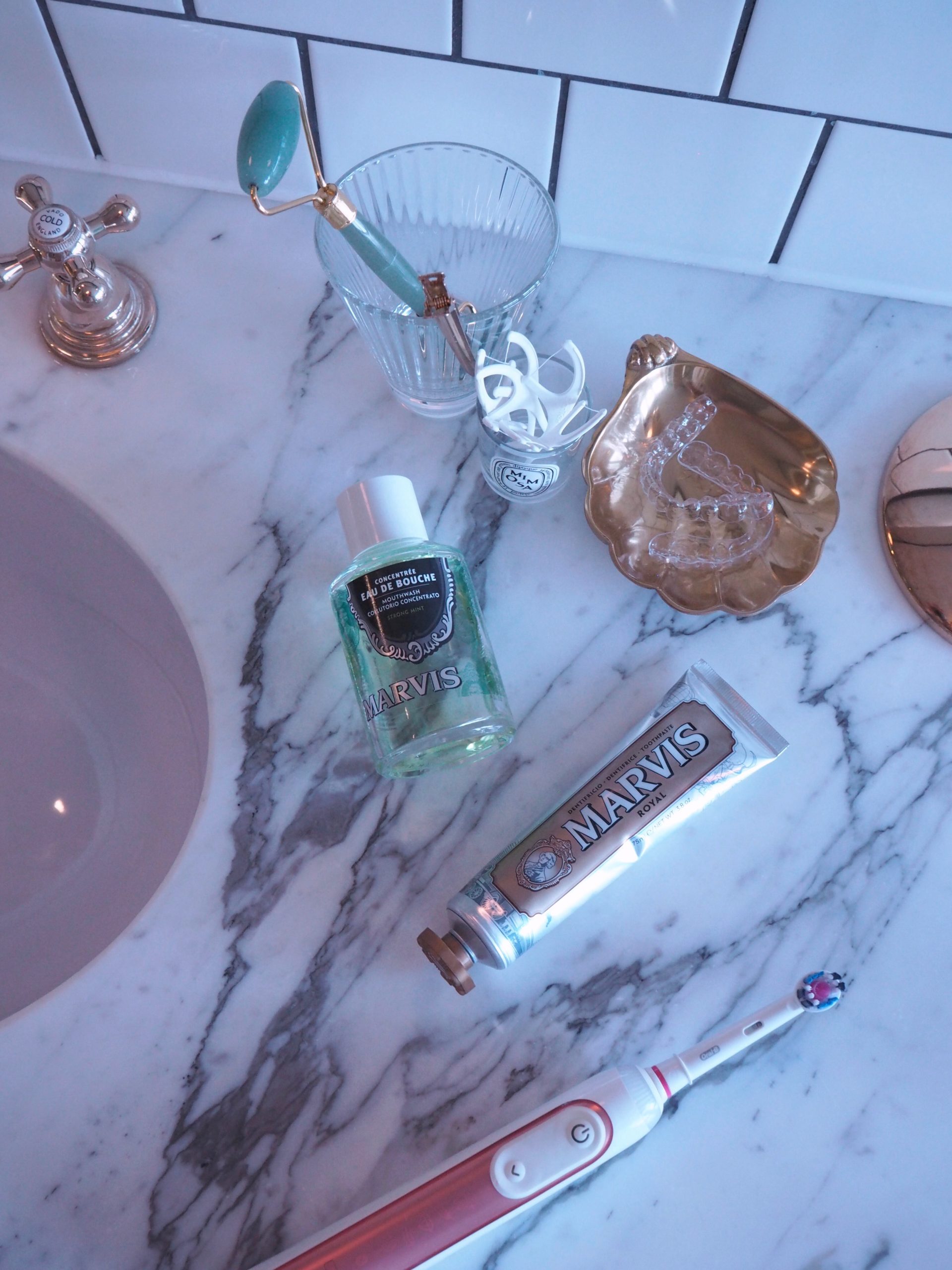
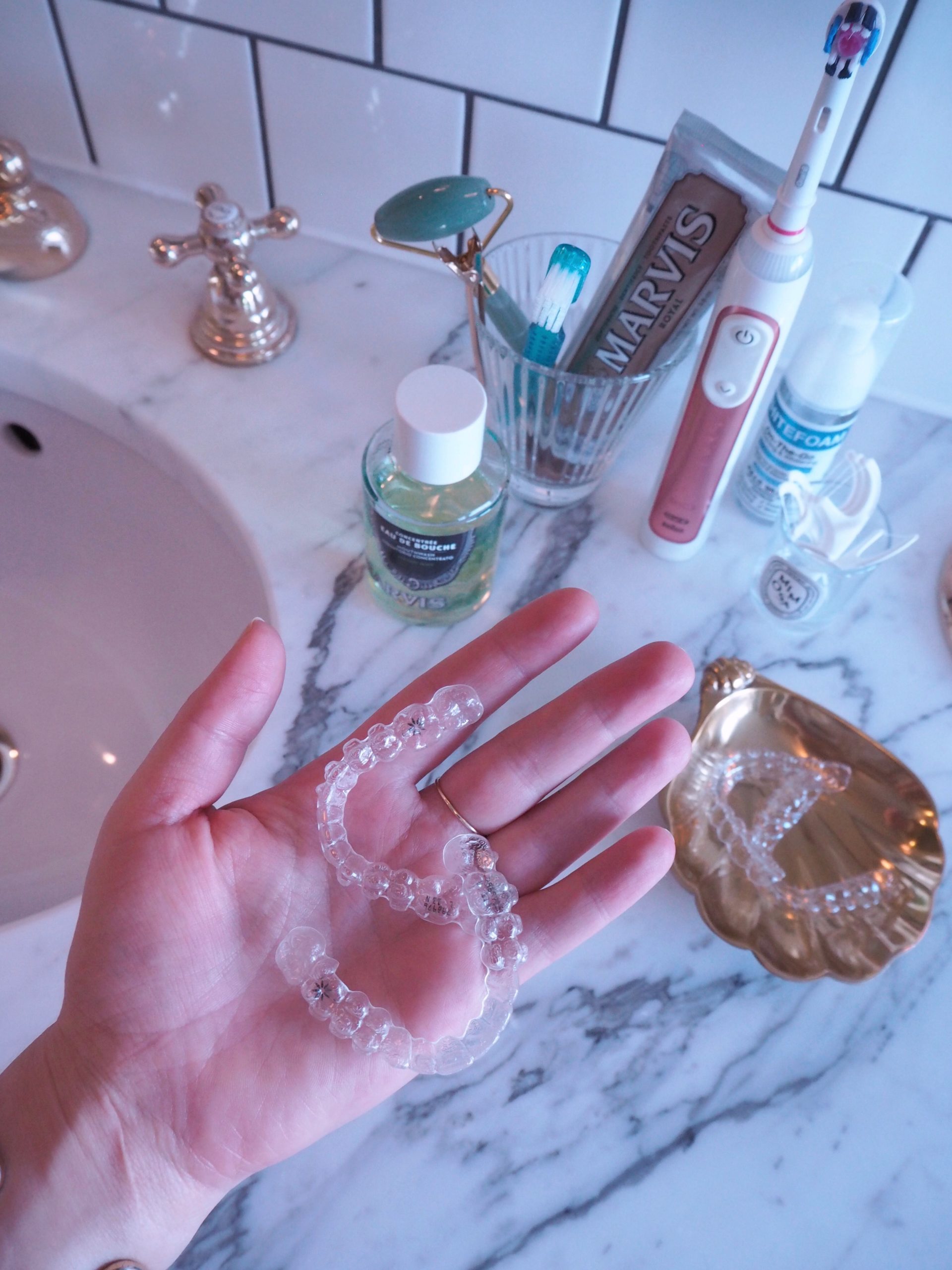 How do you keep them clean?
How do you keep them clean?
Every time I’d remove my aligners and put them back in, I’d give them a good brushing with a separate toothbrush and cold water. Because I was changing my aligners every week, I found they didn’t usually need anything more than that, but you can also clean them with aligner cleaner in a glass of water.
How easy are they to get in and out?
To remove them, just wash your hands and pull gently from the back to lift them out. If you’re having trouble removing them with your fingers, your orthodontist should also be able to give you a remover tool (which looks like a little crochet hook) which was a saviour for me in the first few weeks. To replace them, you just slide them back in with your fingers and gently push until you feel them fit into place, and then use a ‘chewy‘ to bite down and ensure they’re in place as snugly as possible. It takes a bit of practice at first, but I could get mine in and out in just a couple of seconds.
What are ‘attachments’ and did you have any?
Much like the brackets on traditional wired braces, attachments are little nodules that might be attached to the front of any teeth which need a little more help to move as quickly as possible. They’re the same colour as your teeth and made of the same material a dentist would use for a composite filling or to repair a chipped tooth. They’re easily removed once you complete your treatment, and I didn’t find them to leave any marks behind other than a little glue which I can feel right along my gum-line. You might be lucky and not need any, or very few. I was not so lucky and actually needed these on nearly every tooth, but my orthodontist gave me the option to have them put at the back on my top six front teeth so that they weren’t visible. Although having them at the back made my lisp a bit more pronounced and felt a little annoying, I’m glad I did this so that you couldn’t see them when I smiled. This was without a doubt my least favourite part of the whole process (both in terms of appearance and discomfort), so if I were to do my Invisalign treatment again, I’d ask if there was any way I could do it without attachments even if that meant treatment would take longer.
What is ‘IPR’ and did you have it?
If you have any overcrowding before treatment, there’s a good chance your treatment might require IPR, which basically involves your orthodontist filing a teeny tiny gap between one or more teeth so that there’s room for them to rotate into the correct place. I needed this on a few teeth and it was a microscopic amount (just a fraction of a millimetre), only marginally traumatic (but not painful), and the tiny gaps created closed within a few weeks once those teeth straightened into place.
Did you have to have any teeth removed?
I thankfully did not, but I know this can be helpful in cases of extreme overcrowding (and I should note that I had previously had all my wisdom teeth removed as there wasn’t enough room for them to come through in the first place).
Can you get the same results from Clear Direct / Smile Direct / Smile Love (and other online Invisalign alternatives)
Like anything, you get what you pay for. While I can’t speak from experience (having only had Invisalign myself), I cannot see how you could get comparable results from these alternatives. The way I see it, it would be like having an eye test online; they might be able to prescribe you a pair of glasses, but it couldn’t be as accurate as seeing an ophthalmologist, and they wouldn’t be able to check your eye health to ensure you’re getting the best correction for your eyes. Everyone’s teeth are completely different, and everyone’s treatment will be unique. My orthodontist tweaked my treatment plan before we even started to ensure I was happy with the results, and then continually monitored my progress and adjusted my treatment throughout. In addition – because you wouldn’t be seeing an orthodontist – the cheaper online alternatives wouldn’t be able to trim the aligners exactly to your gum line, or incorporate attachments or IPR or other treatment measures which might be crucial to getting the results you want. I think you could only get the same results from seeing an orthodontist for traditional braces, but this wasn’t a route I personally wanted to go down.
Are the results permanent?
Yes, so long as you are willing to opt for some kind of retainer afterwards. As adults, our teeth are constantly shifting slightly; so they will never stay perfectly straight without some kind of help. My orthodontist told me that most of his adult patients are those who never wore a retainer after having braces when they were younger, and their teeth gradually reverted back to how they were. That said, I’ve found my retainers to be both invisible and extremely effortless; putting them in is just one tiny extra step in my evening routine – so it should be easy enough to maintain forever.
Do you have to wear a retainer afterwards?
My orthodontist says that you need to wear a retainer ‘however long you want your teeth to stay straight’; after all, you don’t want to spend all that time and money getting a perfect smile, only for them to gradually shift back over time. Because I want mine to stay perfect for the long haul, I took Dr Scriven’s advice and opted for both a permanent fixed retainer and a Vivera retainer, which I wear every night. I was not thrilled by the prospect of the fixed retainer (a wire that is attached to the back of your front teeth with brackets), but my orthodontist strongly advised me to get it as it’s the best ‘insurance’ in case I ever forget to wear my overnight retainers, or neglect to take them with me when I travel, etc. They definitely took a few weeks to get used to (both in terms of feel and figuring out how to floss around them) but now that I’m used to it, it’s no big deal. The Vivera retainer actually looks exactly like an Invisalign aligner (you can see it in some of these pictures) so it’s just as invisible and easy to wear. I just brush + floss my teeth and put the retainers in before I go to bed, and then remove and brush the retainers with cold water in the morning (and after 6 months of wear, they still look completely clear and perfect). They are also ideal for whitening, or to stop you grinding your teeth if that’s something you’re prone to doing in your sleep.

 If you’re considering Invisalign, I hope this post is helpful! Let me know if you have any other questions in the comment section below, and I’ll do my best to answer them.
If you’re considering Invisalign, I hope this post is helpful! Let me know if you have any other questions in the comment section below, and I’ll do my best to answer them.
Love, Briony xx
This is not a sponsored post, although I did receive a generous discount on my Invisalign treatment via Anglia Orthodontics. As always, this does not alter my views and all opinions remain my own.

Big thanks for this post! I found it enormously helpful, even way over here across the pond, and being a good 20 years older than you
I’m so glad you found it helpful!
Briony xx